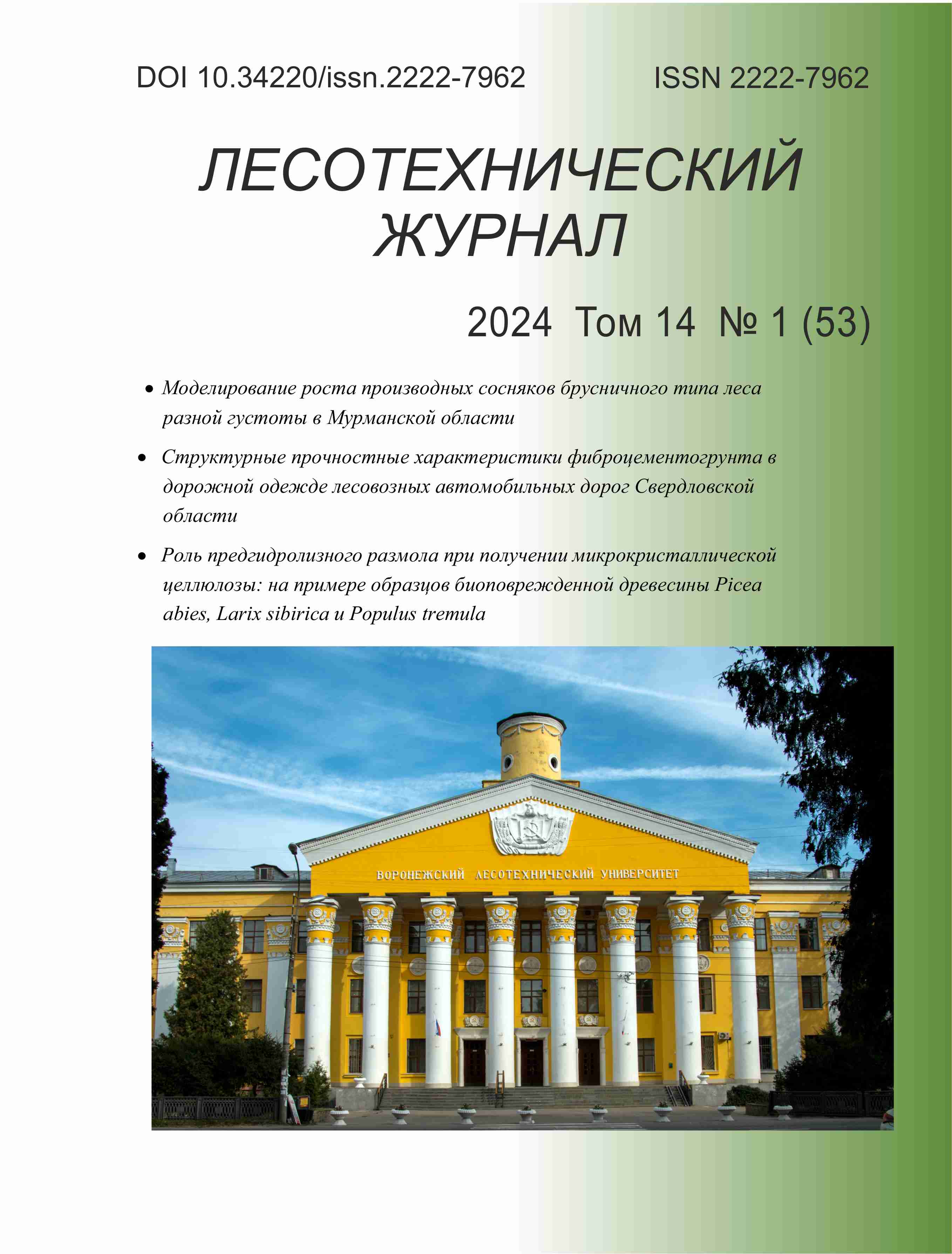Sofia, Bulgaria
UDC 630
Based on data about the growth in height of different coniferous tree species, namely Scots and Austrian pines (Pinus sylvestris L. and Pinus nigra Arnold), Norway spruce (Picea abies (L.) Karst.) and silver fir (Abies alba Mill.), have their growth rates within the same age range been investigated. New coefficients have been suggested for estimating their types of growth and the suitability of using these coefficients has been proved, as they have been compared with the Douhovnicov’s zero natural indicators for the particular curves, and a high level of correlation has been found. The important parametric (qualitative) growth-rate curves, the curves of the normal numbers for the height growth of the four coniferous tree species are presented and analyzed, as well as the index curves. Further on, while applying the new growth-type coefficients, the values and ranges of the growth-rate indices have been found for the tree species investigated. It has been concluded that the growth-type coefficients, as well as the growth-rate indices, are tools quite comfortable and rather suitable for finding differences and similarities between the rates and types of the growth of forest stands.
growth rate, growth type, stand-quality level, coniferous stands, tree species
1. Davidov, M. V. On the Matter of Finding by Measurements in the Field the Types of Growth of Tree Growing Stocks). Forest Journal. 1977:6 (in Russian).
2. Davidov, M. V. Differentiated Establishment of the Quality Levels, Taking into Account the Peculiarities of their Growth in Height. Forestry, 1980:4.
3. Davidov, M. V. The results of the study of types of growth of forest stands of the main forest-forming species in Ukraine. Forest Journal, 1984: 5.
4. Diego Rodríguez de Prado, Jose Riofrío, Jorge Aldea, James McDermott, Felipe Bravo and Celia Herrero de Aza.Species Mixing Proportion and Aridity Influence in the Height–Diameter Relationship for Different Species Mixtures in Mediterranean Forests. Forests 2022, 13, 119. https://doi.org/10.3390/f13010119.
5. Douhovnikov Yu. Morphological classification – the basis for increasing the productivity of forests. Sofia. 1966: 25–40 (in Bulgarian).
6. Douhovnikov Yu., Iliev A. Tables of the rate of growth of Scots pine, Spruce and Fir according to types of forest stands. Collection. Increasing the productivity of coniferous forests. Zemizdat, Sofia. 1972 (in Bulgarian).
7. Douhovnikov Yu., Iliev A. Growth and productivity of various types of forest stands in our country. Collection. Increasing the productivity of coniferous forests. Sofia. 1972 (in Bulgarian).
8. Douhovnikov Yu., Bogdanov K. Dynamic stand-quality level and habitat conditions. Sp. Forestry. 1979: 12 (in Bulgarian).
9. Douhovnikov Yu. General dynamic classification according to stand-quality level. Scientific works, VLTI, vol. XXV. 1980 (in Bulgarian).
10. Facundo J. Oddi, Cecilia Casas, Matías G. Goldenberg, Juan P. Langlois, Jennifer B. Landesmann, Juan H. Gowda, Thomas Kitzberger, Lucas A. Garibaldi. Modeling potential site productivity for Austrocedruschilensis trees in northern Patagonia (Argentina) // Forest Ecology and Management. 2022. Iss. 524. 120525. P. 1-12. https://doi.org/10.1016/j.foreco.2022.120525.
11. Jarosław Socha, Luiza Tyminska-Czabanska, Ewa Grabska, Stanisław Orzeł. Site index models for main forest-forming tree species in Poland. Forests 2020. V. 11. Article 301. https://doi.or9/10.3390/f11030301.
12. Krustanov Kr., Raykov R. Handbook of dendrobiometry. Determination of the stand-quality level of tall beech stands (Gerhard). Bulpofor. 2004: 420 (in Bulgarian).
13. Kyle W. Tomlinson, Lourens Poorter, Frans Bongers, Fabian Borghetti, Loes Jacobs, Frank van Langevelde. Relative growth rate variation of evergreen and deciduous savanna tree species is driven by different traits. Annals of Botany 2014. V. 114, Iss. 2. P. 315–324. https://doi.org/10.1093/aob/mcu107.
14. Markov I., Mihov I. Professor Douhovnikov’s Natural indicators. Forest science. 2007;4:59-86 (in Bulgarian). https://naukazagorata.com/wp-content/uploads/2009/03/ivmarkovn.pdf.
15. Mihov I. On the Dynamic Determination of the Quality Levels of Tree Growing Stocks. Sat. International Anniversary Scientific Conference, Sopron. 1983 (in Russian).
16. Mihov I. Indices for Identifying the Types of Growth of Growing Stocks. The Forestry Journal, 1984;4:49-52 (in Bulgarian).
17. Mihov I. A Method of Identifying the Types of Growth of Growing Stocks and Its Application into the Differentiated Establishment of the Quality Levels of Natural Stands of Scots Pine. Dissertation, 1986:49-52 (in Bulgarian).
18. Mihov I., PetrinR. Indices for Identifying the Types of Growth of Natural Stands of Beech. In: Second Balkan Conference on Studying, Protecting and Using Forest Resources, (3-5 June 1996, Sofia), Volume. I. 1996: 50-53 (in Bulgarian).
19. Mihov, I. Forest Mensuration. RI939C Litera, Sofia. 2005:120-121 (in Bulgarian). https://knizhen-pazar.net/sold_products/books/777691-gorska-taksatsiya.
20. Nedyalkov, S. On the Growth and Productivity of Seed-Tree Beech in Our Country. In: Research Papers of the Forest Research Institute - Sofia. 1960; VIII:131-146(in Bulgarian).
21. Petrin, R. Regularities of the Growth of Beech Stands and Using These in Forest-Management Planning, 1988:41-90 (in Bulgarian).
22. Petrin, R. Index method and its application in the study of the structure and growth of forest stands. Scientific researches of the Union of Scientists in Bulgaria-Plovdiv, series B. Natural Sciences and the Humanities, Vol. HXI; 2021, p. 113-125. ISSN 1311-9192 (Print), ISSN 2534-9376 (On-line). https://usb-plovdiv.org/wp-content/uploads/2021/05/2021_estestveni_i_hum....
23. Petrin, R. Growth-rate Indices and Growthtype Coefficients inHeight of Deciduous Forest stands.Forest Engineering journal, 2022, Vol. 12, No. 4 (48), pp. 47-59. DOI: https://doi.org/10.34220/issn.2222-7962/2022.4/4.
24. Poryazov Ya., Tonchev T. and Dobrichov I. A Forest Surveyor’ s Handbook: Determination of the Stand-quality level of Natural Stands of Scots Pine, Tyurin A.S. p.42. Determination of the stand-quality level of Seed-Tree Stands of Durmast oak, Hungarian oak, hairy oak and Turkey oak, Wiemenauer. 2004:214. (in Bulgarian) https://knizhen-pazar.net/products/books/3010504-narachnik-na-taksatora
25. Mario Trouillier, Marieke van der Maaten-Theunissen, Tobias Scharnweber, Martin Wilmking. A unifying concept for growth trends of trees and forests – the «Potential natural forest». Frontiers in Forests and Global Change. 2020. Vol. 3. Article 581334. https://doi.org/10.3389/ffgc.2020.581334.
26. Yeongwan Seo, Daesung Lee, Jungkee Choi. Growth pattern analysis of major coniferous tree species in South Korea. Forest Science and Technology. 2017. Vol. 14 (1). P. 1–6. https://doi.org/10.1080/21580103.2017.1409660.












